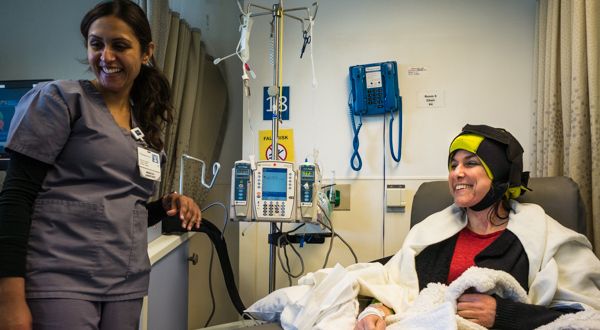Article
Hair Preservation Is an Option During Chemotherapy
Author(s):
The Rapunzel Project is dedicated to spreading the word about hair-preserving treatments for patients undergoing chemotherapy.
A patient uses the DigniCap to preserve hair during cancer treatment. - Courtesy of the Rapunzel Project

A patient uses the DigniCap to preserve hair during cancer treatment. - Courtesy of the Rapunzel Project
After being diagnosed with breast cancer, many patients’ first thoughts are, understandably, about their survival outcomes. But after being given a treatment plan and the assurance that they will live, another question creeps into their minds: Will my chemotherapy treatment cause me to lose my hair?
That was one of the thoughts that Nancy Marshall had when she was diagnosed in 2006. Luckily, her breast cancer was early-stage, so she only needed surgery, not chemotherapy. But when her good friend Shirley Billigmeier was diagnosed three years later in 2009, she was given a treatment plan that included a lumpectomy, radiation and chemotherapy. And then once again, hair loss became a major concern.
But through a friend, Billigmeier heard about cooling caps, which cool and constrict hair follicles, reducing the amount of chemotherapy that gets to the hair, therefore limiting hair loss.
Billigmeier’s oncologist told her that he hasn’t heard much about the cooling caps, and was a bit apprehensive that they wouldn’t work, but said that she was free to try them if she wished. So the women had an industrial freezer set up in the infusion room.
“On the day of her third chemo, when she shouldn’t have had a strand on her head, we walked through the infusion center and staff members were lined up to see Shirley. When she walked in with a full head of hair, there were tears in the nurses’ eyes,” Marshall said in an interview with CURE.
Billigmeier then looked at her friend and said, “If I still have my hair after six chemotherapy treatments, we need to tell people about this.”
She did. And so the two women established the Rapunzel Project.
The Rapunzel Project’s main mission is to spread awareness about the cooling caps — two of which, the Paxman Scalp Cooling System and the DigniCap, have received Food and Drug Administration (FDA) clearance since the inception of the Rapunzel Project.
“Our mission from the beginning was to create awareness that there was an efficacious method or preserving hair during chemotherapy,” Marshall said, noting that more and more people now know about cooling caps, but awareness still isn’t where she wants it to be. “We still get too many emails saying people are two chemos in and just heard of it.”
Billigmeier and Marshall know how important hair preservation can be to patients facing cancer.
“If you can take away the most feared side effect of chemotherapy, you’re changing a patient’s journey,” Marshall said. “If you can go through your illness with a relative amount of looking normal, you maintain privacy. If you have your privacy, you can choose who you want in the circle of people who know and people who support you.”
The Rapunzel Project teams up with salons and hair care companies to spread the word. They also provide detailed information to patients, the medical community and media outlets.
“Maintaining your identity and sense of self is so hugely valuable that we just felt we needed to let people know that this was out there,” Marshall said.
And while the Rapunzel Project does not currently offer financial assistance for patients to be treated with cooling caps, Billigmeier and Marshall are strong advocates for lowering their price and getting insurance coverage.
“[We are] very anxious for the day when Medicare and private insurance steps up to the plate on this,” Marshall said. “Choosing to get a cold cap should not be a financial decision.”
The use of cooling caps is growing, Marshall said. And though the system may not yet be perfect, we are heading in the right direction.
“It’s really exciting to see the medical community saying, ‘the time has come.’ It’s not a perfect system and doesn’t work for everyone, but it’s the only way patients can potentially save their hair during treatment.”
















